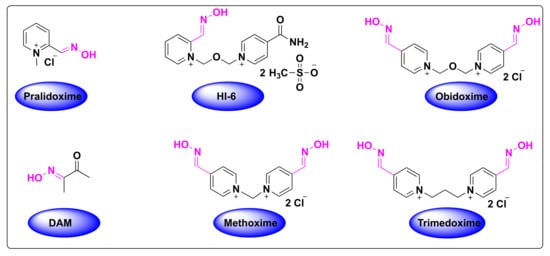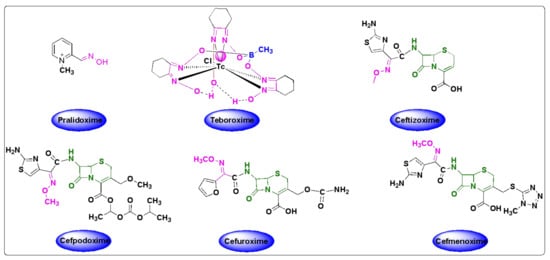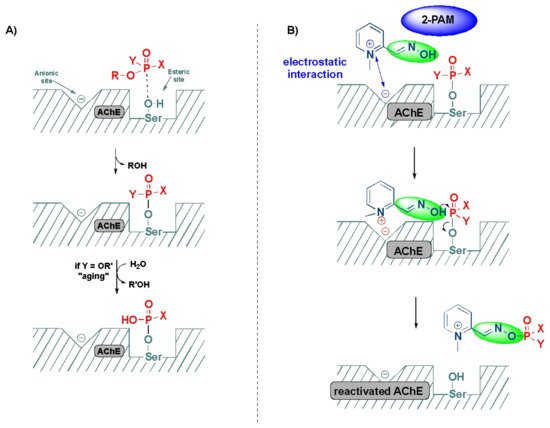Organophosphate (OP) poisoning continues to be a major threat to humans. Oximes represent the most important class in medicinal chemistry, renowned for their widespread applications as OP antidotes, drugs and intermediates for the synthesis of several pharmacological derivatives. Common oxime based reactivators or nerve antidotes include pralidoxime, obidoxime, HI-6, trimedoxime and methoxime, among which pralidoxime is the only FDA-approved drug. Cephalosporins are β-lactam based antibiotics and serve as widely acclaimed tools in fighting bacterial infections. Oxime based cephalosporins have emerged as an important class of drugs with improved efficacy and a broad spectrum of anti-microbial activity against Gram-positive and Gram-negative pathogens.
1. Introduction
Oximes are the most common and widely acclaimed nitrogen containing biological motifs, with diverse biological and pharmacological applications. These hydroxy-imine derivatives are regarded for their antibacterial, anti-fungal, anti-inflammatory, anti-oxidant and anti-cancer activities [
1,
2]. Oximes have gained wide popularity due to their potency to act as antidotes against nerve agents. This is achieved by their ability to reactivate the enzyme—acetyl-cholinesterase (AChE) [
3]. Organophosphates (OPs) are the compounds commonly used as pesticides, insecticides, medications and as nerve agents in chemical weapons. These compounds are extremely toxic and OP poisoning symptoms can vary from nausea, vomiting, diarrhea, muscle tremors and confusion, and can lead to fatality in a few minutes to days, depending on the toxicity of the agent [
4].
A seminal work by Wilson et al., demonstrated that cholinesterase inhibition by the OPs can be reversed by hydroxamic acid and other oxime derivatives, and can therefore be used as powerful antidotes [
5]. This discovery was further extended in the year 1958 by Grob et al., who reported two novel oximes named pyridine-2-aldoxime or pralidoxime (2-PAM) and diacetyl monoxime (DAM) as adjunts to atropine, which can reverse the neuromuscular block due to OP poisoning and activation of AChE [
6]. Ever since the discovery of 2-PAM for organophosphate poisoning, a large number of bioactive compounds bearing oxime moieties were synthesized by various research groups towards the development of more effective antidotes. In addition to 2-PAM, other oxime derivatives, such as obidoxime, HI-6, trimedoxime and methoxime, were used as one of the standard antidotes for OP poisoning (
Figure 1). Nevertheless, the antidote 2-PAM is the only FDA-approved drug until now, for the treatment of OP poisoning (
Figure 1).
Figure 1. Chemical structures of oxime-based nerve antidotes.
In addition to being used as OP antidotes, oxime-based cephalosporins are utilized as anti-microbial agents [
7]. Among the β-lactam antibiotics, penicillin and cephalosporin drugs are the most widely and commonly prescribed anti-bacterial agents against infections [
8]. The discovery of cephalosporin C in the 1950s, paved the way to the development of hundreds of novel cephalosporins [
9]. Mechanistically, cephalosporin C is subjected to chemical or enzymatic hydrolysis to obtain 7-aminocephalosporanic acid, which serves as a key intermediate to synthesize several cephalosporin derivatives [
10]. Oxime based cephalosporins are widely used drugs against bacterial infections and, among them, cefuroxime, ceftizoxime, cefpodoxime and cefmenoxime are FDA-approved oximes used against several bacterial infections (
Figure 2).
Figure 2. Chemical structures of FDA-approved oximes.
1.1. The Sources and Discovery of Oximes
Oximes constitute a very important class of compounds in plants and serve as key players in the metabolism and a variety of biosynthetic pathways [
11,
12]. A wide range of oximes are found in plants and several structurally diverse oximes are involved in the metabolism of plant growth and development. The most common varieties include volatile organic compounds, cyanogenic glucosides and glucosinolates, which explains the ubiquitous nature of these enzymes in plants [
11].
1.2. The Synthesis of Oximes
Oximes have gained wide interest in the field of organic chemistry due to their ease of synthesis from the carbonyl compounds, and their facile conversion to nitriles, amines, nitro compounds and other heterocyclic compounds [
18]. In addition, they are popular as protecting groups of carbonyl compounds and as intermediates in the Beckmann rearrangement for the synthesis of important β-lactam derivatives [
19]. Oximes have wide ranging industrial applications and a classic example of their significance is indicated by the great production of caprolactam, which is a precursor to nylon-6, whose production exceeds over five million tons per year [
20].
1.3. Isomerism of Oximes
Oximes generally exist in the form of interconvertible
E and
Z stereoisomers, depending on the orientation of groups around the C=N bond [
24]. These isomers can have different physical properties and can be readily isolated by chromatography or recrystallization techniques. Oxime stereoisomers have important pharmacological properties and studies revealed that
Z-isomers are more stable and predominant than
E-isomers. Differential scanning calorimetry studies also proved this fact that heating and melting of
E-oxime readily afforded the
Z-oxime. Interestingly, the reagents used for the synthesis of oximes from aldehydes and ketones can also catalyze the interconversion of
E and
Z isomers. Temperature plays a critical role in the determination of the isomer ratio, as any change in the temperature can vary the position of equilibrium and subsequently alter the equilibration ratio of the isomer mixture [
25].
2. Classification of FDA-Approved Oximes
Despite the growing number of oxime-based compounds that have passed clinical testing and are already widely used for medicinal purposes, the FDA approved only six of them, which include pralidoxime, teboroxime (a myocardial imaging agent) and four oxime-based cephalosporines.
2.1. Oximes as Organophosphate (OP) Poisoning Antidotes
Tetraethylpyrophosphate (TEPP) was the first OP, synthesized in 1854 by the French chemist Philippe de Clermont [
35]. The general structure of OPs was first provided by Schrader in 1937, which is comprised of esters or thioesters or anhydride derivatives of phosphoric acid [
36]. OPs contain a facile leaving group, which is prone to hydrolysis and is eliminated by the phosphorylation of acetylcholinesterase [
37].
2.2. Significance of Acetylcholinesterase and Its Inhibition in OP Poisoning
Acetylcholinesterase (AChE, also known as acetylcholinehydrolase) is an enzyme that catalyzes the hydrolysis of neurotransmitter acetylcholine to choline and acetic acid (or acetate) [
53]. Acetylcholine is a major neurotransmitter found in the central and peripheral nervous systems, best known for the transmission at the neuromuscular junction and at ganglionic synapses, and is broken down by the action of AChE [
36]. AChE is composed of a serine site and an anionic site. The serine site is embedded in the active site of the enzyme and is prone to OP attack, ultimately resulting in the phosphorylation of serine site and the inactivation of AChE through the formation of a strong covalent bond. This irreversible binding results in the AChE inhibition by excessive cholinergic stimulation on the nicotinic and muscarinic receptors. This overstimulation can result in a variety of symptoms based on the type of receptor. Hyperstimulation of muscarinic receptors can lead to nausea, vomiting, diarrhea, seizures, abdominal cramps, incontinence of feces and urine, while the hyperactivation of nicotinic receptors can result in hypertension, muscle cramps, fasciculations, tachycardia and paralysis [
54]. Death in patients due to OP poisoning, commonly occurs from the respiratory failure.
2.3. Detoxification of OP Poisoning by Pralidoxime
The inactivation of AChE by OPs leads to the accumulation of acetylcholine in the exposed patients, resulting in the overactivation of muscarinic and nicotinic receptors, which ultimately culminates in the range of aforementioned symptoms [
55]. The mechanism of action of the reactivation of AChE by oximes can be best described using the FDA-approved drug, 2-pyridine-aldoxime methyl chloride (2-PAM) (also known as pralidoxime), as a classic example (
Figure 7). The 2-PAM is the most popular and well-investigated agent, along with HI-6 and obidoxime [
4,
36,
56]. The 2-PAM has a positively charged quaternary nitrogen atom of the pyridinium ion that specifically interacts with the anionic site of the AChE, and, then, the hydroxyl group of the oxime moiety replaces the serine residue by nucleophilic substitution, releasing the free hydroxy (OH)-group of the amino acid (
Figure 7) [
57,
58,
59]. This can be explained due to the higher affinity of 2-PAM to become phosphorylated over the serine residues by the OP agent, and thereby liberating the enzyme and making it available to bind to acetylcholine [
53]. This AChE restoration relieves the associated symptoms of OP poisoning, such as muscle twitching and tremors, convulsions, difficulty breathing and fatigue [
36].
Figure 7. (A) Organophosphate poisoning of AChE. (B) Reactivation of AChE by pralidoxime.
4. Oxime Based FDA Approved Drugs
4.1. Pralidoxime
Pralidoxime is an FDA-approved acetylcholinesterase reactivator and is the most used oxime for the treatment of OP poisoning. In addition to being approved as an antidote for the nerve agent poisoning, it is also most often used as an antidote for OP poisoning in conjunction with atropine. Although it exists in various other salt forms, such as mesylate, methiodide and methyl sulfate forms, chloride is the most predominant form of 2-PAM, owing to its low molecular weight, excellent water solubility and high potency [
53,
54,
80]. The minimum therapeutic amount of 2-PAM was reported to be 4 µg/mL in the blood plasma, which can be reached within 15 min of a single intramuscular injection, and a similar dose can be repeated after one hour of the symptoms [
81]. Maximum concentration is reached within 35 min [
53,
80]. Pralidoxime acts by the binding of the pyridine moiety next to the damaged organophosphate-modified serine site in the AChE, and the nucleophilic attack of the phosphorus atom by the oxime oxygen.
4.2. Teboroxime
Teboroxime or technetium-99m-teboroxime (Tc-99m-teboroxime) is a small, neutral, lipophilic mixture obtained from the boronic acid adducts of technetium dioxime complexes (BATOs) [
94,
95,
96]. It is synthesized from methylboronic acid, stannous chloride and 99m-technetium salts following the synthetic route, as shown in
Scheme 2. It is used as a myocardial perfusion imaging agent, ever since FDA approval in the year 1991 [
97,
98]. Tc-99m-teboroxime was then withdrawn from the market because of rapid clearance kinetics that did not allow high qualities of the images [
85]. Nevertheless, it was taken back to the market, in some countries, for the solid-state photon emission computed tomography (SPECT). Its pharmacokinetics and distribution were discussed in relation to coronary artery disease and ischemia [
99,
100].
Scheme 2. Synthetic scheme of teboroxime.
4.3. Oxime-Based Cephalosporins
β-lactam antibiotics: The discovery of
Penicillium by Alexander Fleming, in 1928, represents a remarkable milestone in the history of science, as it revolutionized the field of medicinal chemistry towards the development of various anti-bacterial drugs against a spectrum of bacterial infections [
102,
103]. Today, β-lactam antibiotics have emerged as the most common and widely used tools to treat the bacterial infections and include several classes, such as penicillins, cephalosporins, carbapenems, β-lactamase inhibitors and monolactams [
8,
104,
105]. They inhibit the bacterial cell wall synthesis by interfering with the biosynthesis of peptidoglycan, which occurs when antibiotics bind to specific penicillin binding proteins involved in the transpeptidation reactions, ultimately leading to bacterial cell lysis and death [
8,
10]. Cephalosporins are a large group of β-lactam derivatives, first isolated from the fermentation products of
Cephalosporium acremonicum near a sewage coast of Sardinia [
9].
This entry is adapted from the peer-reviewed paper 10.3390/ph15010066




